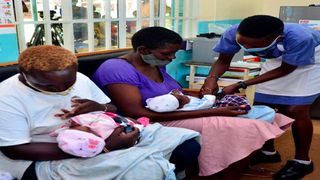
Nurse Winnie Akoth (right) immunizes children brought by their mothers at Yala Sub-County Hospital in Siaya County last week.
News
Premium
How malaria is killing unborn children
She was happily cuddling her three months old son when we visited her house in Rodi Kopany, Homa Bay County.
This is the first time Ms Jane Atieno is carrying a bundle of joy to term after three miscarriages that almost cost her marriage and respect from friends and even in-laws.
When Ms Atieno was pregnant with her first baby in 2015, it was the best news ever. She had unsuccessfully tried to get a baby for two years.
Since she had missed her periods, she definitely knew she was expectant. She thus bought a pregnancy test kit and tested herself.
“I was pregnant. I was happy at least I had cemented my marriage. I really wanted to be a mother,” she said.
But when she was three months into her pregnancy, she developed abdominal pain but did not take it seriously thinking it was just a bad case of excess gas.
However, it worsened and in the evening, she was shaking and sweating. She had not started her antenatal clinics.
In the next few hours , she was crying in pain and she noticed she was bleeding.
“I lost my pregnancy. It was over,” Ms Atieno told the Sunday Nation.
Given that she was staying in Homa Bay County which is one of the high-risk malaria counties, the three months wait before starting her clinic was a mistake.
She did not go for a check-up after losing her pregnancy, she got traditional concoctions to clean her tummy as advised by her traditional birth attendant.
“This was a shock to my husband but he was supportive and I could feel how disappointed he was but he never lost hope,” she says
Four months after her loss, she conceived. She had faith her family was growing.
She carried the pregnancy for three months and lost it again the same way. This is the time the in-laws were on her case.
Supportive
“Marry another woman. Your wife has a problem and it is likely she aborted when she was still a girl. Why is she miscarrying? She is a bad omen, she will never carry a baby to term,” they told Jane’s husband.
He changed, started coming home late, and stopped being supportive like he was before.
She decided she was going to try for the last time, got pregnant again but lost it again at two months.
Ms Atieno’s losses, she later on came to know, were caused by malaria. This is because she did not attend her antenatal clinic and thus did not receive the recommended medicines to protect her and her baby from malaria.
When she got her fourth pregnancy, with the help from the CHW, she started her antenatal clinic at four weeks.
She was immediately tested for malaria and she had severe malaria. Up to six per cent of her red blood cells were infected.
In all her pregnancies, she had a fever, cough and difficulty in breathing as well as nausea and vomiting.
Explaining what could have led to the miscarriages in Ms Atieno's case and many other women in the county, Millicent Oluoch, technical officer, Impact Malaria explained that Homa Bay is a malaria-endemic zone.
The mothers on many occasions have the malaria-transmitting parasite but it is hidden in the placenta.
“Since the mothers have been bitten many times by mosquitoes, they have partial immunity to malaria unlike the placenta which is a new tissue and does not have any immunity. So when they get malaria, the parasite is passed into the placenta leading to alteration of the tissues in the placenta hence reducing oxygen and nutrients supply to the baby,” says Ms Oluoch.
This slows the growth of the baby and causes severe maternal anaemia hence leading to miscarriages which might be unknown to the mother.
Antenatal care
“We encourage mothers in this region to start their clinics earlier so that they get the treatment earlier,” she says.
In 2019, the Ministry of Health estimated Malaria in pregnancy to be 6.3 per cent among women attending their first antenatal care (ANC) visit.
Malaria kills hundreds of thousands of people every year, especially young children.
It’s also exceptionally dangerous: pregnant women are at-risk groups.
Malaria is caused by parasites that are transmitted to people from mosquito bites. Last year, at least 400,000 deaths globally were attributed to malaria mostly under five in Sub-Saharan Africa with more than 200 million cases of malaria.
It is still one of the world’s deadliest killers.
Through Impact Malaria, community health workers are trained on how to identify malaria in pregnant women and encourage mothers to go to clinics at the health facility and to start their journey early.
Ms Atieno was attached to a community health worker, her pregnancy monitored and she received her doses of the drug as well as provided with a treated mosquito net.
“For every clinic visit, I was given the malaria medicine which had to be taken at the dispensary before leaving for home,” says Ms Atieno.
Ms Atieno gave birth to a healthy baby boy.
To protect pregnant women and their babies from malaria in areas of moderate-to-high transmission rates, such as sub-Saharan Africa, the WHO recommends a minimum of three doses of intermittent preventive treatment in pregnancy with sulfadoxine-pyrimethamine (IPTp-SP) administered with each scheduled visit.
Kenya adopted the treatment of Malaria in pregnancy and the drug is given after a 12 weeks gestational period and four weeks apart until the pregnant woman delivers.
In areas with high malaria transmission such as Western, Nyanza, and Coast regions, Long-Lasting Insecticidal Nets (LLINs) are provided at the clinic during the first clinic visit.
Dr Robert Bonyo, Homa Bay county malaria coordinator explained to the Sunday Nation that malaria prevention at times is difficult because of shortages leading to stock-outs.
“Whenever there is stock out, the uptake of the service is affected and this means that women are going without their drugs and hence risk getting infected with malaria,” Dr Bonyo said
The drug has shown to reduce the risk of placental infection and the associated risk of maternal anaemia, miscarriage, premature deliveries, neonatal death and low birthweight. Pregnancy increases the risk of malaria infection in all women.
Pregnant women
Previously, the drug also known as Fansidar was used to treat malaria in the general population, however, it was withdrawn and currently being used to treat malaria in pregnant women.
According to the international health agency, it is always advisable that the treatment is initiated as early as possible to prevent malaria in pregnancy, thereby reducing maternal and fetal anemia, stillbirths, spontaneous abortion, low birth weight and newborn deaths.
However, despite the advocacy to expectant mothers to attend clinics and get the drugs to prevent malaria, in some of the counties, women don’t have access to the drugs, the drug is normally out of stock hence putting them at risk of getting malaria. Most women are going without the drug.
Dr Robert Bonyo, Homa Bay County malaria coordinator explained to the Sunday Nation that prevention at times becomes a great challenge because the supply for the commodities hence the logistical challenges in supplies leading to stock-outs.
“Whenever there is stock out, the uptake of the service is affected and this means that women are going without their drugs and hence risk getting infected with malaria,” Dr Bonyo said.
The women are always advised to buy the drug in private chemists. This is not practically more so to those who cannot afford this will later have an impact on the pregnancy that might result in more cases of malaria in pregnant women causing adverse effects to the mother and the unborn baby.
Last year, the county experienced a number of stock-outs which impacted on the counties indicators, the number of pregnant mothers infected with malaria increased.
Annually, the country records around 260 cases however, compared to last year, the cases 500 cases annually.
“This is a great concern and we are hoping that the issue of stock out will be addressed,” Dr Bonyo said.
Expectant women
In Homa Bay County, uptake of malaria prevention services among pregnant women is still low especially for the drug. In 2016, 60 per cent of pregnant women in Homa Bay were taking their drug, this has since dropped to 42 per cent
“This means that in ten expectant women, only four are accessing the drugs and being a vulnerable population, this is of great concern, the uptake has majorly been influenced by unavailability of services due to commodity stock-outs,” Dr Bonyo said.
A new study published in The Lancet: Child and Adolescent Health estimates that malaria accounts for 10 to 20 percent of maternal mortality in countries where malaria is endemic is malaria-related. That’s almost 30,000 women every year and 90 women per day.
Kenya has done tremendously well to reduce the numbers of malaria cases it has not done as much as we could for pregnant women and the overall toll of malaria is much larger than we might realize when its effects on pregnancy loss are fully considered.
According to the paper published last week, malaria infection at delivery is associated with some 200,000 stillbirths per year in sub-Saharan Africa with up to 100,000 infant deaths each year are attributable to low birth weight caused by maternal infection with P falciparum during pregnancy in Africa.




